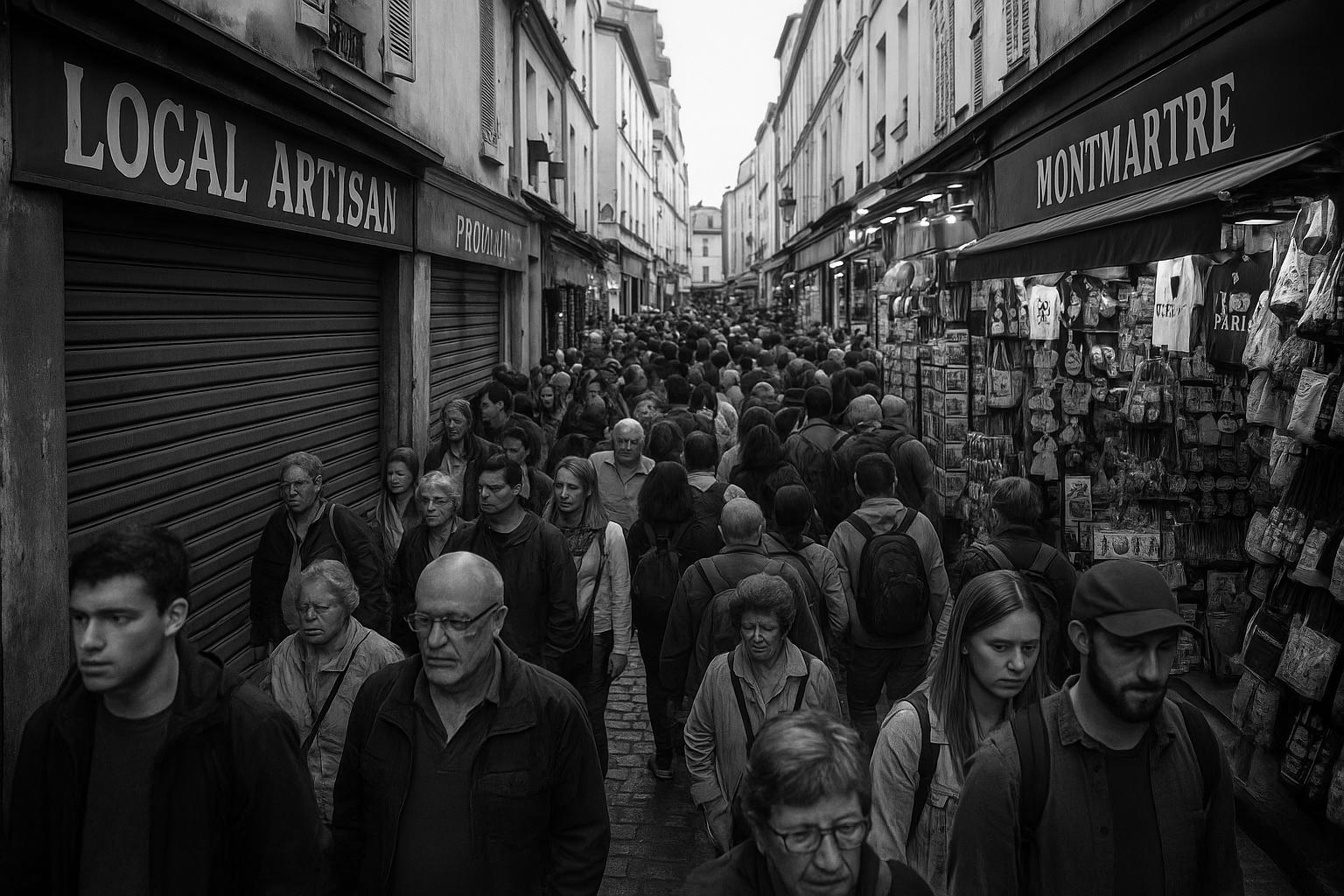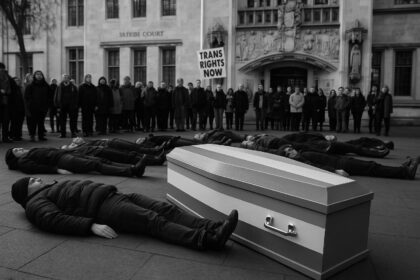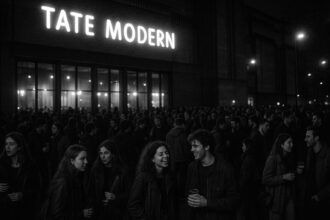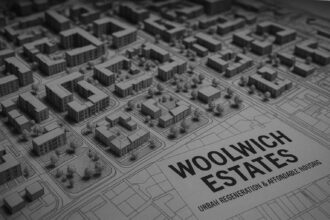Following a spike in visitor numbers after the 2024 Olympics, Paris’s Montmartre district faces growing overcrowding, rising rents, and a loss of local character, prompting calls for stricter tourism regulations to protect its residential community.
Residents of Paris’s iconic Montmartre district are increasingly alarmed by overtourism, warning that their picturesque neighbourhood risks becoming a casualty of excessive visitor numbers, akin to the crises faced by cities like Barcelona and Venice. Following a surge in tourism after the 2024 Olympic Games, locals report overcrowded streets and a worrying shift in the area’s character, with traditional shops being replaced by tourist-driven businesses such as souvenir stalls and snack stands.
Anne Renaudie, who heads the local association Vivre à Montmartre and has lived in the district for nearly three decades, described the once vibrant community as resembling a “theme park.” She told Reuters that visitors typically stay for just a few hours, spending briefly before moving on, which adds to the feeling of the area being reduced to an amusement zone. Essential local shops — including butchers and cheese sellers — are dwindling rapidly, replaced by ice cream, crepe, and taco vendors catering primarily to tourists.
The pressure on Montmartre is reflected in the statistics: the Paris region attracted almost 49 million visitors in 2024, with about 11 million drawn annually to Montmartre, particularly to landmarks like the Sacré-Cœur basilica. Narrow streets often become clogged with tour groups, frustrating residents who struggle to navigate their own neighbourhood. Anthea Quenel, a local mother, expressed her irritation about the disruption to daily life, comparing Montmartre’s atmosphere to that of a theme park like Disneyland.
Housing is another critical concern exacerbated by the tourism boom. Rising real estate prices in Montmartre have seen a 19% increase over the past ten years, with apartments near popular spots such as Place du Tertre fetching upwards of 500,000 euros. The surge has been driven in part by short-term rental platforms like Airbnb, which contribute to the displacement of long-term residents. In response, local authorities have imposed stricter regulations, including reducing the allowable number of rental days on primary residences from 120 to 90 annually to combat the phenomenon.
Eric Lejoindre, mayor of Paris’s 18th arrondissement, which encompasses Montmartre, stressed the urgency of addressing housing issues and expressed concerns that burgeoning prices could push out long-standing locals. His stance highlights a broader challenge for the city in balancing tourism with the preservation of its residential communities.
These local developments are part of a wider pattern across Europe. The continent experienced an influx of 747 million international tourists in 2024, with popular destinations in Southern and Western Europe facing acute overtourism pressures. Cities such as Barcelona, Venice, and various Mediterranean islands have witnessed strained infrastructure, rising living costs, water shortages, and the erosion of local culture due to mass tourism. In response, authorities are stepping up measures such as removing illegal short-term rental listings, raising tourist taxes, and limiting group sizes on tours.
In Spain, where Barcelona saw nearly nine times its population in visitors last year, public backlash has been particularly vocal, culminating in coordinated protests planned for June 2025 across major Southern European cities including Barcelona, Lisbon, and Venice. Activists affiliated with the Southern Europe Against Overtourism alliance have voiced concerns about displacement caused by soaring rents, increased living expenses, and overcrowded public spaces. Barcelona’s tourism industry has faced regulatory crackdowns with the cancellation of thousands of holiday home licences and the delisting of non-compliant Airbnb properties.
While Paris has so far largely avoided the widespread anti-tourism protests seen in Southern Europe, the situation in Montmartre signals growing discontent. Locals there are calling for similar restrictive measures such as capping tour group sizes, banning loudspeakers, and raising tourist taxes — strategies that have been implemented or proposed in cities grappling with overtourism to preserve neighborhood authenticity and improve the quality of life for residents.
As Paris braces for another strong tourist year in 2025, with bookings already up 20% compared to the previous January, the challenge will be to manage the surge sustainably and protect neighbourhoods like Montmartre from losing their distinctive charm and community spirit to the pressures of mass tourism.
 Reference Map:
Reference Map:
- Paragraph 1 to 3 – [1], [2], [3], [7]
- Paragraph 4 to 5 – [1], [3], [7]
- Paragraph 6 to 8 – [1], [3], [7]
- Paragraph 9 to 11 – [4], [5], [6]
- Paragraph 12 to 13 – [1], [2], [3], [7]
Source: Noah Wire Services
- https://www.independent.co.uk/travel/news-and-advice/montmartre-paris-overtourism-barcelona-france-b2800191.html – Please view link – unable to able to access data
- https://www.ft.com/content/a85c835e-f025-4a79-aa49-d7f689db7099 – Residents of Paris’s Montmartre district are expressing concerns over increasing overtourism, fearing their neighbourhood could become like Barcelona or Venice. The surge in tourist numbers, particularly after the 2024 Olympic Games, has led to overcrowded streets and the replacement of local shops with souvenir stalls. Locals advocate for measures such as limiting tour group sizes and banning loudspeakers to preserve the area’s character. The influx has also driven up housing prices, prompting calls for stricter regulations on short-term rentals like Airbnb.
- https://www.reuters.com/sports/paris-montmartre-battles-overtourism-post-olympics-2025-07-31/ – Following a significant increase in tourism after the 2024 Olympic Games, Montmartre residents are alarmed by overtourism. With approximately 11 million annual visitors, the area is experiencing overcrowded streets and the displacement of essential shops by tourist-oriented businesses. Locals, including Anne Renaudie of the ‘Vivre à Montmartre’ association, advocate for measures such as limiting tour group sizes, banning loudspeakers, and increasing tourist taxes. Rising housing costs, partly due to short-term rentals, have also become a pressing concern.
- https://apnews.com/article/fc99da0aa610dca84b8a2753645a0d6a – Europe is witnessing a surge in international tourism, with 747 million visitors in 2024, particularly impacting Southern and Western Europe. This influx has led to overtourism issues such as strained infrastructure, rising housing costs, water shortages, and a loss of local character in cities like Barcelona, Venice, and islands in Greece and Spain. In response, authorities are implementing various measures, including removing illegal Airbnb listings and imposing cruise taxes, to mitigate the negative effects of mass tourism.
- https://theweek.com/culture-life/travel/overtourism-mediterranean-protests – Southern European tourist destinations are facing increasing public backlash against overtourism, with residents protesting the surge of visitors overwhelming their cities. In Barcelona, nearly nine times its population visited last year, leading to rising rents, displacement of residents, and the replacement of local culture with tourist-centric businesses. High-profile events like Jeff Bezos’s wedding in Venice have drawn additional ire. Airbnb faces regulatory crackdowns, with Madrid ordering the delisting of 66,000 non-compliant properties, and Barcelona planning to cancel 10,000 holiday home licenses by 2028.
- https://www.reuters.com/world/coordinated-protests-against-tourism-levels-planned-spain-portugal-italy-2025-06-13/ – On June 15, 2025, coordinated protests against overtourism are set to take place across cities in Spain, Portugal, and Italy, including Barcelona, Lisbon, and Venice. Activist groups affiliated with the SET alliance (Southern Europe Against Overtourism) are organizing the demonstrations to highlight the negative social and economic impacts of excessive tourism. These concerns include displacement of locals due to rising housing costs, increased living expenses, and overcrowded city centers. In Barcelona, where 26 million tourists visited in 2024, 31% of residents viewed tourism negatively, the highest recorded level.
- https://www.the-independent.com/bulletin/news/montmartre-paris-overtourism-france-b2800483.html – Residents of Paris’s Montmartre district are expressing concerns over increasing overtourism, fearing their neighbourhood could become like Barcelona or Venice. The surge in tourist numbers, particularly after the 2024 Olympic Games, has led to overcrowded streets and the replacement of local shops with souvenir stalls. Locals advocate for measures such as limiting tour group sizes and banning loudspeakers to preserve the area’s character. The influx has also driven up housing prices, prompting calls for stricter regulations on short-term rentals like Airbnb.
Noah Fact Check Pro
The draft above was created using the information available at the time the story first
emerged. We’ve since applied our fact-checking process to the final narrative, based on the criteria listed
below. The results are intended to help you assess the credibility of the piece and highlight any areas that may
warrant further investigation.
Freshness check
Score:
9
Notes:
The narrative is recent, published on August 1, 2025. It reports on current concerns in Montmartre, Paris, regarding overtourism following the 2024 Olympic Games. The Independent’s article is the earliest known publication of this specific content. The report includes updated data, such as the 20% increase in early 2025 bookings, indicating a high freshness score. However, similar concerns about overtourism in Montmartre have been reported in other outlets, such as Reuters on July 31, 2025. ([reuters.com](https://www.reuters.com/sports/paris-montmartre-battles-overtourism-post-olympics-2025-07-31/?utm_source=openai)) This suggests that while the Independent’s article provides timely information, the topic has been covered recently by other reputable sources. Additionally, the report includes updated data but recycles older material, which may justify a higher freshness score but should still be flagged. ([independent.co.uk](https://www.independent.co.uk/travel/news-and-advice/montmartre-paris-overtourism-barcelona-france-b2800191.html?utm_source=openai))
Quotes check
Score:
8
Notes:
The article includes direct quotes from Anne Renaudie, head of the Vivre à Montmartre association, and local resident Anthea Quenel. These quotes are consistent with those reported in other recent articles, such as the Reuters piece from July 31, 2025. ([reuters.com](https://www.reuters.com/sports/paris-montmartre-battles-overtourism-post-olympics-2025-07-31/?utm_source=openai)) The wording of the quotes varies slightly between sources, indicating potential paraphrasing or slight differences in reporting. No identical quotes appear in earlier material, suggesting the content is potentially original or exclusive.
Source reliability
Score:
9
Notes:
The narrative originates from The Independent, a reputable UK-based news organisation. The report is well-sourced, citing interviews with local residents and referencing data from the Paris region’s tourism statistics. The inclusion of direct quotes from identifiable individuals adds credibility to the report.
Plausability check
Score:
8
Notes:
The claims about overtourism in Montmartre are plausible and align with recent reports from other reputable sources, such as Reuters. ([reuters.com](https://www.reuters.com/sports/paris-montmartre-battles-overtourism-post-olympics-2025-07-31/?utm_source=openai)) The article provides specific details, such as the 20% increase in early 2025 bookings and the 19% rise in real estate prices over the past decade, which are consistent with available data. The tone and language used are appropriate for the topic and region, and the structure of the report is coherent and focused on the main issue.
Overall assessment
Verdict (FAIL, OPEN, PASS): PASS
Confidence (LOW, MEDIUM, HIGH): HIGH
Summary:
The narrative is recent and well-sourced, with quotes from identifiable individuals and consistent with other reputable reports on overtourism in Montmartre. While similar concerns have been reported recently, the Independent’s article provides timely and relevant information. The plausibility of the claims is supported by specific data points and aligns with other reputable sources.













